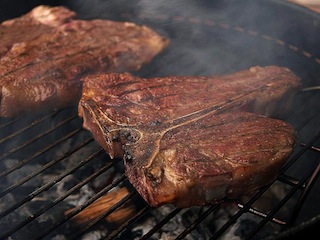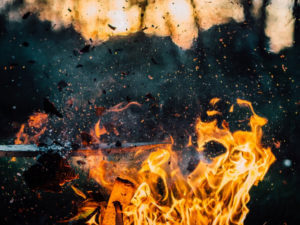How to Cook Lean Grass Fed Beef
Treat your tastebuds to an ethical feast: grill up some grass fed! You'll probably pay a little more for your t-bones, but you'll be supporting small-scale farmers and those who use the most planet-friendly methods of raising livestock possible. In fact, if you support truly well-managed grass fed beef farmers, you don't need to feel guilty at all.
But in the meantime, you probably need some pointers on how to treat your premium, pasture-raised porterhouse cuts or filet mignons. Grass fed beef is a different animal than your bargain-priced grocery store steak. Here to help you cook it to perfection is farmer and cookbook author Shannon Hayes.
The following is a collection of recipes from cookbooks by Shannon Hayes.
How to Cook the Perfect, Tender, Grass Fed Steak
The simplest, most commonly heard distinction made between grassfed and factory-farmed meat is that grassfed is leaner. As we've just seen, that is not always the case. The real difference lies in the fact that, by virtue of a beef animal's active and healthy life, there is true muscle integrity in the meat. This is wildly different from the feedlot animals, which get little or no exercise, resulting in more flaccid (and, hence less flavorful) cuts. This does not mean that grassfed steaks are less tender – on the contrary. Cooked more gently, grassfed meat is wonderfully tender. The healthy muscle texture does, however, mean that grassfed steaks will be more variable than grainfed meats. Taste and texture of steaks will vary based on breed, farming practices, pastures, and individual animal characteristics. Thus, the trick to cooking a delicious steak is to work with the variability and take advantage of that beautiful muscle quality.
 We should be treating this meat as "tenderly" in the kitchen or on the grill as the farmers treated the animals in the fields. When cooking a grassfed steak, we want to achieve a delicious sear that creates a pleasant light crust on the exterior of the meat, then allow it to finish cooking at a much lower temperature; this allows the naturally-occurring sugars to caramelize on the surface, while protecting those muscle fibers from contracting too quickly. Tough grassfed steaks result from over-exposure to high heat, which causes the muscle fibers to contract tightly and become chewy and overly dry.
We should be treating this meat as "tenderly" in the kitchen or on the grill as the farmers treated the animals in the fields. When cooking a grassfed steak, we want to achieve a delicious sear that creates a pleasant light crust on the exterior of the meat, then allow it to finish cooking at a much lower temperature; this allows the naturally-occurring sugars to caramelize on the surface, while protecting those muscle fibers from contracting too quickly. Tough grassfed steaks result from over-exposure to high heat, which causes the muscle fibers to contract tightly and become chewy and overly dry.
Keeping these principles in mind, below are two techniques for cooking a fantastic steak, using the same seasonings. The first technique, taken from The Farmer and the Grill, is for working outdoors with open flames, my preferred method, YEAR ROUND. If you plan on winter grilling, be sure to check out the list of tips for safe winter grilling that appear at the end of this article.
The second technique is taken from my newest cookbook,Long Way on a Little: An Earth Lovers' Companion for Enjoying Meat, Pinching Pennies and Living Deliciously. Much to my surprise, not every family on the North American continent has access to an outdoor grill – hard to believe! Thus, in an effort to include you in the thrill that comes from eating the best-tasting steak available, I've included an indoor steak recipe that guarantees your grassfed meat will remain tender and juicy. Enjoy!
The Best Steak – Outdoors
Recipe adapted from Farmer and the Grill: A Guide to Grilling, Barbecuing and Spit-Roasting Grassfed Meat…and for saving the planet, one bite at a time, by Shannon Hayes
(The amount of seasoning you will use will vary based on the size of your steak. If it is close to one pound, use less. If it is closer to 2 pounds, use more.)
Ingredients
- 1-2 tablespoons coarse salt
- 1-2 teaspoons ground black pepper
- 1-2 cloves garlic, minced
- Either 1 sirloin, sirloin tip, tri-tip, top round or London Broil, rib eye, porterhouse, t-bone, top loin (NY Strip) or tenderloin (filet mignon) steak. Steaks should be at least 1 ¼ – 1 ½ inches thick.
Procedure
- Combine the salt, pepper and garlic in a small bowl. Rub the mixture into both sides of the steak, then allow the meat to come to room temperature while you prepare the grill.
- Start the grill and warm it until it is hot. If you are using a gas grill, turn off all but one of the burners once it has come up to temperature. If you are using charcoal, be sure all the coals have been raked to one side. Use the hand test: the grate will be hot enough when you can hold your palm 3-4 inches above the metal for no more than three seconds.
- Sear the steaks for 2-3 minutes on each side directly over the flame, with the lid down. Then, move the steaks to the part of grill that is not lit. Set the lid in place and allow the steaks to cook, without flipping them, until they reach 120-135 degrees**, about 10-20 minutes, depending on the size of the steak. Remove the steaks to a platter and allow them to rest a few minutes before serving.
The Best Steak – Indoors
Recipe taken fromLong Way on a Little: An Earth Lovers' Companion for Enjoying Meat, Pinching Pennies and Living Deliciously, by Shannon Hayes
(The amount of seasoning you will use will vary based on the size of your steak. If it is close to one pound, use less. If it is closer to 2 pounds, use more.)
Ingredients
- 1-2 tablespoons coarse salt
- 1-2 teaspoons ground black pepper
- 1-2 cloves garlic, minced
- 2 tablespoons butter, tallow or rendered lamb fat
- Either 1 sirloin, sirloin tip, tri-tip, top round or London Broil, rib eye, porterhouse, t-bone, top loin (NY Strip) or tenderloin (filet mignon) steak. Steaks should be at least 1 ¼ – 1 ½ inches thick.
Procedure
- Combine the salt, pepper and garlic in a small bowl. Rub the mixture into both sides of the steak then allow the meat to come to room temperature.
- Preheat the oven to 200°, then heat a large cast iron skillet or other oven-proof skillet over a high flame. Once the skillet is so hot that you can see a little smoke rising off of it, add the butter or fat. Sear the steak for two minutes on each side.
- Turn off the flame, and insert an instant-read meat thermometer into the boneless edge of the steak – do not insert it into the top, as there is not enough thickness for the thermometer to take an accurate reading.
- Leaving the steak in the skillet, place it in the oven and allow it to finish cooking, about 10-20 minutes depending on the size of the cut, until the internal temperature reads 120-135°. Allow the meat to rest five minutes before carving and serving.
Weren't aware that grassfed meats have different internal doneness temps than grainfed? Get a handy magnetic grassfed temperature guide, the Don't Overdo It Magnet, from grassfedcooking.com. They're inexpensive, and you can feel good about them, because they are made by a small, locally owned factory in my community.
 Winter Grilling Tips
Winter Grilling Tips
Yes, the indoor method described above is terrific. The meat is super-tender and juicy. But I prefer to season with a little smoke and flame. Thus, I've become one of those hard-core advocates of year-round grilling. If you are new to the idea, here are a few tips to get you started.
-
Choose a safe place for grilling outdoors. The garage may not be your best bet, since it probably contains a few explosives, such as cans of gas, or lawn mowers, chainsaws or other vehicles that contain gasoline. I actually have a screened-in porch with a brick floor that shelters me for winter grilling. That's a little more deluxe than most folks have – just try to choose a sheltered spot that isn't too close to your house.
-
Keep the path to your grill site, and the area around it, free of snow and ice. It would be deeply annoying to ruin a perfectly good dinner because of a last-minute trip to the emergency room.
-
Dress wisely. I find that my charcoal throws up a lot more sparks in the winter…or perhaps I've just noticed them more, because I've made the stupid mistake on occasion of wearing drapey and flammable garments, such as winter scarves, out to the coals. Learn from my experience, and don't make the same stupid mistake.
-
Limit your grilling repertoire. It's cold out. Barbecuing is a culinary tradition from the warm south. Unless you have some pretty sophisticated equipment, and are some kind of BBQ Macho-Man (you know who you are), smoking and barbecuing are best relegated to summertime pleasures. Stick to the steaks, burgers and chops. They minimize the trips out to the grill, keeping the cold out of your house and out of your bones.
- Allow extra heat-up and cook times. Extreme outdoor temperatures will affect the warm-up and cooking time of your grill. To accommodate for this, always grill with the lid down, and monitor the internal temperature of your meat with an instant-read meat thermometer. If you are considering buying a gas grill and you plan to use it through the winter, buy the highest BTU rating you can afford. The cold truly slows the heat-up process. Also, high BTUs often accompany higher quality grills, which will do a better job holding in the heat during the winter months. If you are on a budget (like me) or just prefer the flavor (like me), a simple little Weber charcoal kettle will work beautifully for outdoor winter grilling (no, I do not work for them).
Winter grilling is much easier if you are working with the ecologically responsible charwood (available in many hardware or natural food stores) because it is much easier to light, and it quickly gets a lot hotter than composite briquettes. I find that, with the exception of the most extreme weather conditions, I can keep to my normal cook times by simply using a few more coals in the fire. The bonus is that charwood is better for the planet.
For more tips on ecologically responsible grilling, check out my book, The Farmer and the Grill: A Guide to Grilling, Barbecuing and Spit-Roasting Grassfed Meat…And for saving the planet, one bite at a time.
Shannon Hayes is the host of grassfedcooking.com and radicalhomemakers.com. She is the author of Radical Homemakers, Farmer and the Grill, and The Grassfed Gourmet. Hayes works with her family producing grassfed and pastured meats on Sap Bush Hollow Farm in Upstate New York.
Recommended Reads
Preparing and Cooking Rabbit
RECIPE: Grilled Nopalitos with Herbs and Cotija
Source: https://www.chelseagreen.com/2021/how-to-cook-the-perfect-tender-grassfed-steak/
0 Response to "How to Cook Lean Grass Fed Beef"
Post a Comment